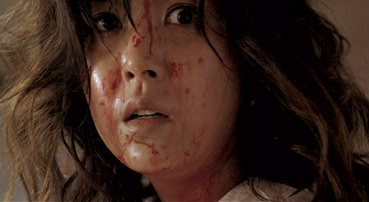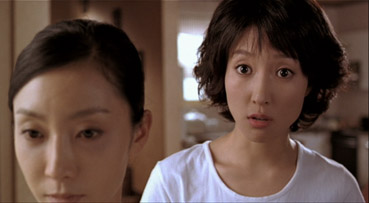|
Korean
cinema is certainly in vogue at the moment, not least thanks
to the works of Park Chan-wook (the Vengeance trilogy) and Bong Joon-ho (Memories
of Murder and the upcoming The Host),
whose films are frankly wiping the floor with their western
equivalent, if indeed they can be said to have an equivalent. Korean
horror has also made itself known, with films such as Whispering
Corridors, Phone and A
Tale of Two Sisters finding an audience beyond
the domestic market, although we still await the Korean-made
horror film that has the widespread impact of (or frankly
is as scary as) the best that Japan or Hong Kong have to
offer.
Joining
the horror line-up is first-time director Lee Woo-cheol's
Cello, which is very much in the tradition of the
J-Horror works of recent years, especially those that
borrow from their predecessors. The borrowing itself is
not really an issue – the later films in any genre are going to owe a dept to the pioneers and we rarely see
westerns criticised for including elements that were successfully
employed in Stagecoach, or vampire movies chastised
for the influence of Bram Stoker and Bela Lugosi. But in
these days of second-hand cinema, where just about everything
worthwhile is being remade or ripped off, I've become a little over-sensitive to the recycling process. If you're
going to lift ideas from other movies, well OK, but make
damned sure you do something interesting and/or original
with them.

Cello
(the Korean title is the longer Chello hongmijoo
ilga salinsagan, which I gather translates as Cello:
A Song of Murder) certainly builds on a solid if
well-used foundation. Mi-ju is a cellist turned music teacher
who lives with her loving husband, her two young daughters
and her soon-to-be-married sister. The arrival of a speechless
housekeeper taken on by her husband as a favour to a friend
seems to trigger a series of increasingly sinister events,
all of which point to something in Mi-ju's past that even
her husband is unaware of and that she has tried her best
to forget.
The
plot device of old sins that come back to (literally) haunt
the present has proved a popular one in recent horror cinema, but still has a few miles left on its clock. There are hints
of a troubling but unspecified past event from an early stage,
with flashbacks to a serious accident and wrist scars that
clearly have a tale to tell, but full disclosure is, as
you'd expect, both a long time coming and not quite what
we are intitally led to believe. More than once we are (with
varying degrees of success) misdirected over the cause
of Mi-ju's woes, with one instance of apparent spiritual possession
rationally explained as the dazed result of a romantic bust-up,
only for supernatural forces to pop up anyway and dispatch
the unfortunate victim. As the incidents and bodies pile
up, the demands on your concentration increase, and you'll
need to pay close attention to avoid finding yourself
floundering in "what's going on?" territory.
At a time in which many western genre films are dumbed down
to the point of idiocy, any film that expects its audience
to do a little work to join the narrative dots has to be
seen as a good thing. And when prepared to stand on its
own creative feet, Cello tells its story well, aided
by decent performances and an effective music score.
However...
Although
it is inevitable that any new film made in the J-Horror
tradition is going to be influenced by previous genre successes,
director Lee takes this a step too far by explicitly lifting
ideas and even scenes from the horror hall of fame. The
Omen proves a particularly rich source of cinematic
nibbles, from the sinister housekeeper and the child who
can silence a dog with single look, to deaths by hanging
and a balcony fall. Nakata Hideo's Ringu
is similarly plundered, its most iconic and repeated image
of the eye of the avenging ghost girl making
its unsurprising appearance, and its now famous climax reproduced
with a picture frame standing in for TV. Two particularly
memorable sequences from Shimizu Takashi 's Ju-On
are lifted and combined, as a sleeping Mi-ju is caressed
by a floating black cloud and on waking is terrorised by
a demonic female face beneath her bed-covers.

These
cinematic crutches can't help but suggest a lack of confidence
on the part of either Lee or the studio, using tried and tested elements as
safety net for their own material. For anyone who knows
their J-Horror, however (and let's face it, that's where
Cello's core audience will lie), the reverse
proves true, as you find yourself groaning as you tick off
the movies that have been recycled – my partner, who
is well versed in Eastern horror, was actually shouting
at the TV in places.
The
thing is, Cello genuinely doesn't need this, as nestling
comfortably behind the borrowings is a well thought-out
and effectively developed genre work. It's not particularly original
or as scary as it should be, but once
Lee gets down to doing his own thing it works pretty damned
well, and it's this material that makes the film worth seeing.
Although it could be argued that those new to Eastern horror
will not suffer the same sense of déjà-vu,
I would still recommend they seek out and watch the originals first
and give credit where its due. But Cello
is still a well made and atmospheric piece and if he can esxcape the need to pepper his work with obvious borrowings, bodes well
for director Lee's future projects, whatever they may be.
The packaging claims an aspect ratio of 1.77:1 but my measurements
make it closer to 1.82:1. The picture is anamorphically
enhanced and is in better shape than a fair few
UK DVDs of Eastern horror films, with decent sharpness and
contrast, even in the darker scenes and earthy tinted interiors,
which are pleasingly free of compression artefacts.
The odd dust spot is visible, but the print is otherwise
clean.
Three
soundtracks are on offer: Dolby 2.0 stereo, 5.1 surround
and DTS surround, and as you'd expect, the 5.1 and DTS tracks
are the only way to go. The surrounds are well used, though
the shock moments tend to be aurally fuelled by the same
one-note blasts you'll find in almost any Eastern horror
doing the rounds at the moment.
The
Making Of Featurette (36:10),
unlike the one on the recently released Inner
Senses DVD, does feature a variety of behind-the-scenes
footage, including two scenes of blood-letting, the actresses
laughing their way through a cello playing sequence, and
the green screen set-up for an death scene in which actress
Park Da-an expresses her desire to "die with charisma."
There's also some press conference footage in which the
director and actors talk about working on the film.
The
Trailer (1:49) presents the film
as part of an ongoing horror style and tradition and gives a tad too much away for my liking.
A
decently made and acted Eastern horror that would have registered
higher in my estimation if the filmmakers had left the contents
of the recycling bin alone. It's still definitely worth
checking out, although those most sympathetic to this style
of horror film are also the ones most likely to recognise
the second-hand material. Tartan's DVD does rather well
on picture and very well on sound, even if the extra features
are a tad light.
|